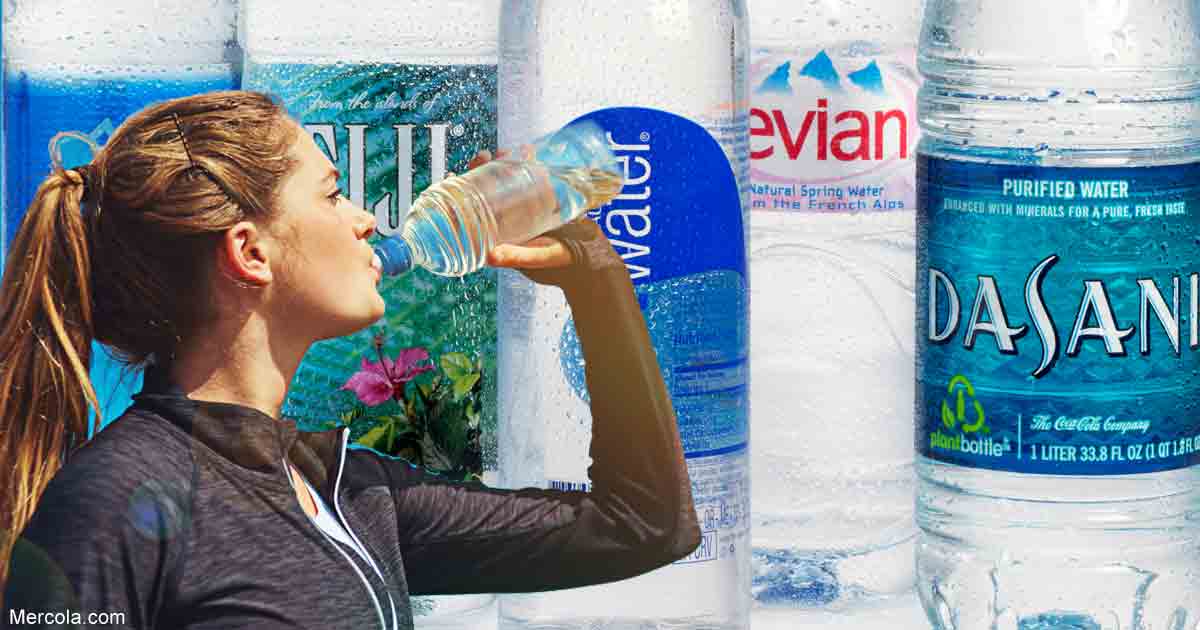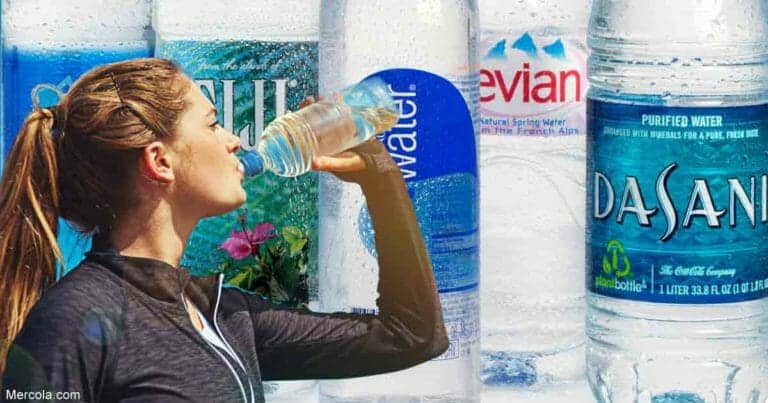Plastic has become an incredibly harmful convenience, now threatening environmental and human health alike, and in more ways than one. With Earth Day being tomorrow [April 2018], there is no better time to analyze the impact bottled water has had on our planet. There’s the issue of bulk plastics in our landfills, where it will remain indefinitely since most plastic does not biodegrade, and microplastics — microscopic pieces of degraded plastic — which now choke waterways across the globe and contaminate drinking water and sea life.
On top of that, there are the chemicals used in the production of plastic, many of which have hormone-mimicking activity, thereby threatening animal and human health, including reproductive health. Disturbingly, recent tests reveal most bottled water contains microplastic pollution — contamination thought to originate from the manufacturing process of the bottles and caps.
The featured CBC marketplace investigation of bottled water found plastic contamination, including rayon and polyethylene, in 30 of 50 water bottles tested. Plastic was even found in bottled water that was sold in a glass container.
Researchers at the State University of New York also tested 259 bottles of 11 popular bottled water brands for the presence of microscopic plastic on behalf of Orb Media, a nonprofit journalism organization. Brands included Aquafina, Nestle Pure Life, Evian, Dasani and San Pelligerino. On average, the bottled water tested contained 325 pieces of microplastic per liter; just over 10 of those pieces were at least 100 microns in size, the rest were smaller.
Most of these bits and pieces are so tiny they’re invisible to the naked eye. To reveal them, the researchers used a special dye that binds to plastic, combined with infrared laser and blue light. Using orange-colored glasses, the particles appear lit up like stars in the night sky when the water sample is viewed under a microscope.
Bottled Water Contaminated With Microscopic Plastic
Overall, only 17 of the 259 bottles were found to be free of microplastic particles…
…and none of the brands tested consistently free of plastic contaminants. The worst offender was Nestlé Pure Life, the most contaminated sample of which contained 10,390 particles per liter, while the least contaminated brand, San Pellegrino, contained a high-end density of 74 particles per liter. Here’s a summary breakdown of the most and least contaminated brands:
[h2oIQ.prg editor’s note: see original article for list of the most- and least-contaminated brands of bottled water.]
As noted in Orb Media’s “Plus Plastic” report:
“Humans need approximately 2 liters of fluids a day to stay hydrated and healthy — even more in hot and arid regions. Orb’s findings suggest that a person who drinks a liter of bottled water a day might be consuming tens of thousands of microplastic particles each year …
For microplastic debris around 100 microns in size … bottled water samples contained nearly twice as many pieces of microplastics per liter (10.4) than the tap water samples (4.45) … According to existing scientific research, the plastic particles you consume in food or drinks might interact with your body in a number of different ways …
Some particles might lodge in the intestinal wall. Others might be taken up by intestinal tissue to travel through the body’s lymphatic system. Particles around 110 microns in size (0.11 millimeters) can be taken into the body’s hepatic portal vein, which carries blood from the intestines, gallbladder, pancreas and spleen to the liver.
Smaller debris, in the range of 20 microns (0.02 mm) has been shown to enter the bloodstream before it lodges in the kidneys and liver … Ninety percent of the plastic particles we found … were between 100 and 6.5 microns — small enough … for some to cross the gut into your body."
World Health Organization Launches Health Review
In response to Orb Media’s report, the World Health Organization (WHO) has vowed to launch a safety review to assess the potential short- and long-term health risks of consuming microplastic in water. WHO’s global water and sanitation coordinator, Bruce Gordon, told BBC News: "When we think about the composition of the plastic, whether there might be toxins in it, to what extent they might carry harmful constituents, what actually the particles might do in the body — there’s just not the research there to tell us. We normally have a ‘safe’ limit but to have a safe limit, to define that, we need to understand if these things are dangerous, and if they occur in water at concentrations that […]
Full article: Most Bottled Water Contaminated With Microplastics
More about microplastic contamination of water:
Study: People Who Only Drink Bottled Water Ingest 90,000 Microplastic Particles Per Year
Microplastics found in more than 90% of bottled water, study says
Microplastics are getting into mosquitoes, contaminating new food chains
Microplastics in our mussels: the sea is feeding human garbage back to us
Microplastic contamination: Plastic fibres found in tap water around the world
Proving Terrible For the Marine Life: Microplastics



